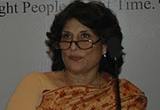 The time is ripe in India to consider under-nutrition as a population issue, rather than a women and children’s issue, as it is viewed presently by government, governmental advisors and experts, and other stakeholders.
The time is ripe in India to consider under-nutrition as a population issue, rather than a women and children’s issue, as it is viewed presently by government, governmental advisors and experts, and other stakeholders.
Apart from worrisome child under-nutrition indicators and infant, child, and maternal mortality rates, indicators of under-nutrition and anemia among adult males and females are equally disturbing. 28.1% of adult men and 33.0% of adult women have a low body mass index, resulting in chronic energy deficiency (CED). 24.3% of adult men suffer from anaemia, ranging from 7.1% in Kerala to 44.6% in Assam, compared with 56.2% of women (NFHS 3, 2005-06). Anaemia in pregnant women has increased from 49.7% in 1998-99 to 57.9% in 2005-06. CED and anaemia together cause stunted stature, low body weight, reduced working capacity and earnings, and additional healthcare costs for the state.
Children and women are undoubtedly the worst sufferers of under-nutrition, owing to a vicious mix of causes—economic, behavioral, cultural, and governance related. Women are historical sufferers because of low social power. Children suffer because they have no social power. In the context of India’s intergenerational cycle of under-nutrition, women and children also become vectors of under-nutrition into the next generation for both sexes.
Adolescent under-nutrition indicators are equally worrisome, particularly when India considers its vast human resource as its greatest asset. The National Nutrition Monitoring Bureau (NNMB) Technical Report 21, 2001, finds the nutritional intake of adolescent girls was below the recommended daily allowance (RDA). More than two thirds of adolescents were consuming < 70% RDA for vitamin A and riboflavin, 53% male and 39.5% female adolescents were underweight, and about 39% of both sexes were stunted.
The subject of under-nutrition has had a chequered history in India. It has travelled through the ministries of community development, food, and agriculture, ending up with the ministry of women and child development during the fifth plan period, (1974-79) when the Integrated Child Development Services Programme (ICDS) was initiated. From then onwards, the subject lost its way and became synonymous with ICDS, and planners got stuck on the belief that under-nutrition had been adequately addressed through it. Only recently, in the budget speech of 2012, was there acknowledgement that under-nutrition needs to be addressed through a cross-sectoral programme, going well beyond the present ICDS.
I recently attended a World Bank South Asia conference at Kathmandu on infant and young child nutrition. Representatives from the Afghanistan and Pakistan Governments were present, and spoke with great determination about how they face the challenges in bringing maternal and child health services to strife torn areas. In both countries, under-nutrition was treated as a population issue and received higher national priority. Going by its population nutritional indicators, it appears appropriate that India too should do the same. A debate on the subject, involving government, civil society, and experts needs to be triggered. An aspiring global power simply cannot have a 50% undernourished population.
Veena S Rao, advisor, Karnataka Nutrition Mission.
